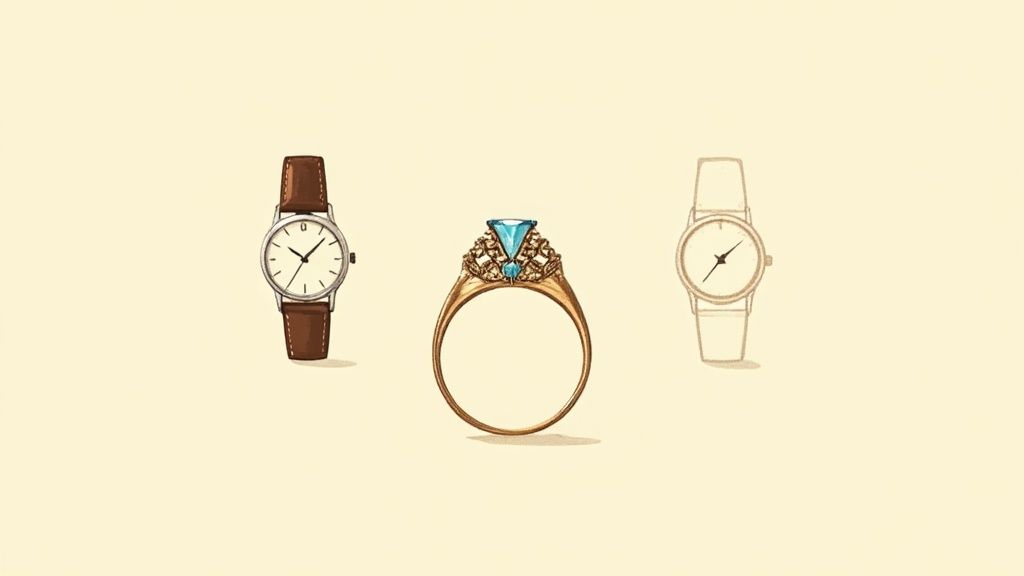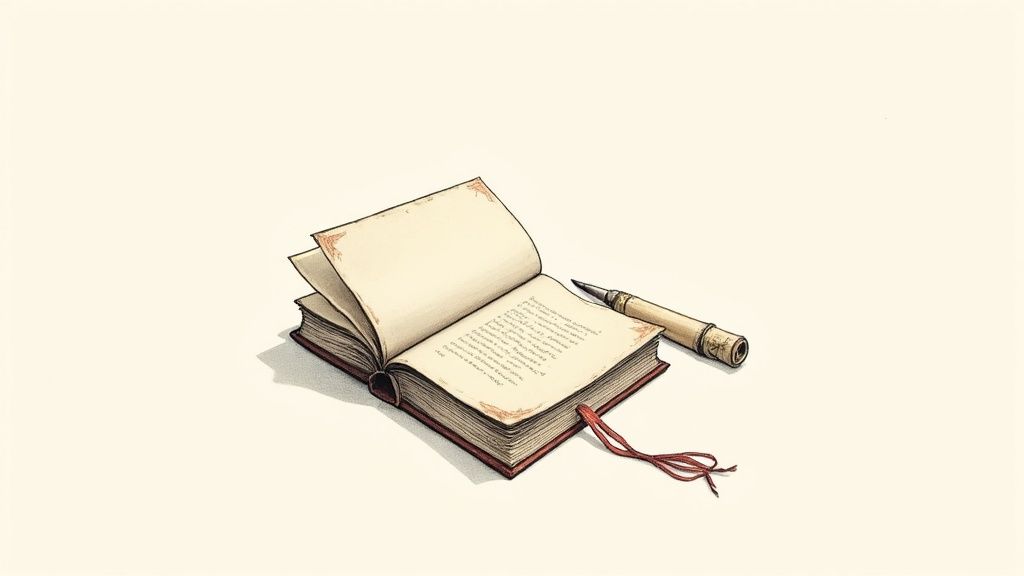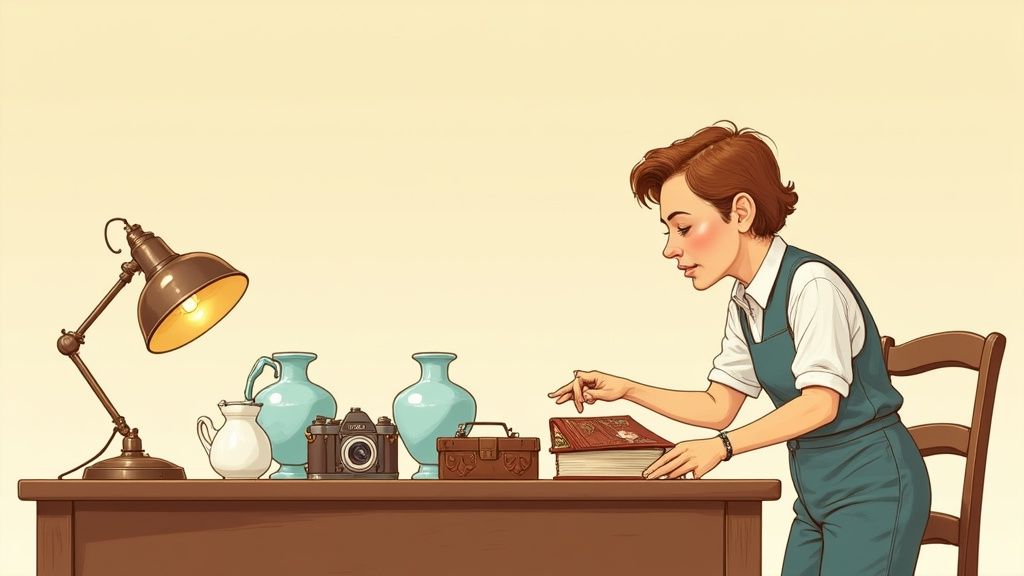Unlocking Hidden Histories: The Thrill of the Hunt
Estate sales are more than just a marketplace for used goods; they are museums of personal history where every object holds a story. For the savvy treasure hunter, these sales offer a unique opportunity to discover valuable, rare, and historically significant items hiding in plain sight. From iconic mid-century furniture to forgotten masterpieces, the potential for incredible estate sale finds is immense. This guide will walk you through seven key categories of treasures to watch for, providing the expert insights you need to identify valuable pieces, understand their worth, and make your next hunt a resounding success.
We will explore what makes these items desirable, how to spot authentic pieces, and the common pitfalls to avoid. You will learn actionable tips for identifying everything from vintage jewelry and rare first editions to antique tools and fine art. With the right knowledge and a keen eye, you can turn a weekend outing into a profitable and fascinating adventure into the past. For those moments when you need an expert in your pocket, an app like Curio can instantly analyze a photo of your find, providing history, context, and valuation, turning uncertainty into confident discovery.
1. Mid-Century Modern Furniture
Among the most coveted estate sale finds, Mid-Century Modern (MCM) furniture stands out for its timeless appeal, exceptional craftsmanship, and significant resale value. Spanning from roughly the 1950s to the 1970s, this design movement prioritized clean lines, organic curves, and functionality, often utilizing materials like teak, walnut, and molded plastic. Unearthing a piece from an iconic designer like Charles and Ray Eames or a manufacturer like Herman Miller or Knoll can be like discovering buried treasure, transforming a modest investment into a substantial profit or a cherished heirloom.
The key to success lies in distinguishing authentic period pieces from later reproductions or similarly styled furniture. While reproductions have their place, original pieces hold the most value. For example, a genuine Eames lounge chair, sometimes found for a few hundred dollars at an estate sale, can be valued at over $5,000. Similarly, a Danish Modern teak dining set bought for $150 might be appraised at $2,000 or more.
How to Spot Authentic MCM Pieces
- Check for Maker's Marks: Look for labels, stamps, or medallions underneath chairs, inside drawers, or on the back of case goods. Brands like Knoll, Herman Miller, and Lane Furniture often marked their work.
- Examine the Construction: Authentic MCM furniture typically features high-quality joinery, such as dovetail joints in drawers, and is made from solid wood or high-grade wood veneers, not particle board.
- Assess the Materials: Pay attention to the wood grain and color. Teak and walnut were popular choices, known for their warm tones and durability. Original pieces will also show a natural patina from age.
Pro Tips for Your Hunt
Before you go, research current market values on sites like 1stDibs or Chairish to know what a fair price is. Arrive at the sale early, as high-value items are the first to go. Always bring a measuring tape to ensure the piece will fit your space. For a deeper dive into identifying furniture from different eras, you can learn more about antique furniture identification. These estate sale finds are not just furniture; they are pieces of design history waiting to be rediscovered.
2. Fine Art and Original Paintings
An estate sale can be a treasure trove for art collectors, offering a rare opportunity to acquire original paintings, sculptures, and prints that have been cherished for decades. These sales often feature diverse collections, from works by promising local artists to signed lithographs from world-renowned masters. The true thrill lies in the potential for discovery, as valuable pieces can be overlooked or misidentified, presenting a chance to find remarkable estate sale finds that are both culturally and financially significant.

The potential return on investment for fine art is immense. For instance, a keen-eyed shopper might discover a Picasso lithograph for $50, which could later be authenticated and valued at over $15,000. It's not just about famous names; a WPA-era painting by a regional artist purchased for $25 might sell for $3,000 to a specialized collector. Even a seemingly ordinary 19th-century oil painting bought for a modest $100 could be appraised at $8,000 or more after professional evaluation.
How to Spot Valuable Artwork
- Look for Signatures: Carefully examine the piece for an artist's signature, monogram, or initials. Use your phone to research the name in artist databases on the spot.
- Check the Back: The back of a painting can be more informative than the front. Look for gallery labels, exhibition stickers, auction house markings, or notes from the artist.
- Assess the Medium and Materials: Observe the quality of the canvas, paper, or board. Older oil paintings often show craquelure (a network of fine cracks), which is a sign of age, not necessarily damage.
Pro Tips for Your Hunt
Before buying, photograph the artwork and its signature to conduct a quick online search for comparable works or artist information. Always factor in potential framing and restoration costs, as these can be significant. A pocket UV light can be a useful tool to quickly check for extensive repairs or in-painting that aren't visible to the naked eye. For serious collectors, building knowledge is key; resources like the Getty Union List of Artist Names can be invaluable for research. These artistic estate sale finds are more than just decoration; they are a direct connection to a creative legacy.
3. Vintage Jewelry and Watches
The small, often overlooked jewelry boxes and display cases at estate sales can harbor some of the most valuable treasures. Vintage jewelry and watches are exceptional estate sale finds because they pack immense value into a small package. These personal collections often contain a mix of everything from high-quality costume pieces by designers like Chanel or Miriam Haskell to fine jewelry with precious metals and gemstones from eras like Art Deco or Victorian. Discovering a luxury timepiece or a signed designer piece can result in a remarkable return on investment.

The potential for profit is staggering, as these items are frequently misidentified or undervalued by estate sale organizers. For instance, a classic Rolex Submariner, mistaken for a common watch and priced at $200, could be worth over $8,000. Similarly, a vintage Cartier bracelet bought for just $50 might be valued at $2,500, and an Art Deco diamond ring purchased for $75 could appraise for $4,000 or more. Success depends on your ability to spot quality and authenticity amidst tangled chains and costume jewelry.
How to Spot Authentic Vintage Jewelry and Watches
- Look for Hallmarks and Maker's Marks: Examine pieces for small stamps indicating metal purity (e.g., 14k, 925) or the manufacturer's name. Iconic brands like Cartier, Tiffany & Co., Rolex, and Omega always mark their work.
- Inspect the Craftsmanship: Authentic fine jewelry features secure stone settings, intricate details, and quality construction. For watches, check for smooth movement of the second hand (in many mechanical watches) and a well-finished case and dial.
- Assess the Materials: Real gemstones will feel cold to the touch and often have natural inclusions visible under a loupe. High-end costume jewelry often uses heavy plating, glass stones, and superior construction compared to modern fast-fashion pieces.
Pro Tips for Your Hunt
Always carry a jeweler's loupe (10x magnification is standard) to inspect marks and details up close. Before you attend a sale, research recent sold prices for brands you're interested in on auction sites. If permitted, ask to test metals with a testing kit. For a deeper understanding of period styles and signatures, you can learn more about how to identify antique jewelry. Arriving early is crucial, as experienced collectors often head straight for the jewelry table, making these estate sale finds a competitive but rewarding pursuit.
4. Rare Books and First Editions
The unassuming bookshelf at an estate sale can be a treasure trove for discerning collectors, holding rare books and first editions that are often overlooked. Personal libraries built over decades frequently contain signed copies, limited printings, and first editions of significant literary works. These books are not just reading material; they are historical artifacts that have often appreciated dramatically in value, making them one of the most intellectually rewarding and potentially lucrative estate sale finds.

The potential return on investment is staggering. For instance, a first edition of Harper Lee's To Kill a Mockingbird found for a mere $5 could be valued at over $1,200, depending on its condition and the presence of the original dust jacket. Similarly, a signed Stephen King novel, often mixed in with common paperbacks, might be purchased for $10 and hold a value of $500 or more. Even niche collections, like a set of 1960s cookbooks bought for $20, can be sold to the right collector for as much as $800.
How to Spot Valuable Books
- Check the Copyright Page: This is the most critical step. Look for the words "First Edition" or "First Printing." For some publishers, like Scribner, a letter "A" on the copyright page indicates a first edition. A number line reading "1 2 3 4 5 6 7 8 9 10" also typically signifies a first printing.
- Examine the Dust Jacket: An original dust jacket in good condition can account for up to 80% of a modern first edition's value. Check for the original price on the flap and ensure the artwork matches known first-edition copies.
- Assess the Condition: Note any foxing (brown spots), torn pages, writing (unless it's the author's signature), or damage to the spine. The better the condition, the higher the value.
Pro Tips for Your Hunt
Quickly scan shelves for famous authors known for collectible works, such as Ernest Hemingway, J.K. Rowling, or Dr. Seuss. Before the sale, familiarize yourself with online resources like AbeBooks or Biblio to check market values on the spot. Don't discount non-fiction; old technical manuals, unique cookbooks, and early scientific texts can also be highly valuable. These literary estate sale finds connect you to history, offering a tangible link to the past that can also be a fantastic investment.
5. Vintage Musical Instruments
Hidden within the quiet corners of an estate sale, vintage musical instruments represent some of the most exciting and potentially lucrative finds. These items, ranging from electric guitars and violins to brass instruments and pianos, often come from the homes of dedicated musicians or lifelong collectors. Discovering an instrument from a renowned manufacturer like Gibson, Martin, or Steinway can yield a remarkable return, as these pieces are valued for their superior craftsmanship, unique tonal qualities, and historical significance.
The potential for high value is immense, turning a casual purchase into a significant asset. For instance, a 1960s Gibson Les Paul guitar, sometimes found for a few hundred dollars by an unassuming seller, can be worth upwards of $15,000 to a serious collector. Likewise, a dusty vintage violin picked up for $100 could be appraised at over $5,000 if it originates from a respected European workshop. Even less common finds, like a 1950s trumpet bought for $50, might be valued at over $1,200.
How to Spot Valuable Instruments
- Check for Maker's Marks and Serial Numbers: Look for logos, stamps, or labels on the headstock of guitars, inside the F-holes of violins, or engraved on the bells of brass instruments. These markers can be researched online to determine the exact year and model.
- Examine the Condition: Carefully inspect the instrument for cracks, warping, or signs of significant repair. While some wear adds character, major structural damage can drastically reduce value. Original hardware and finish are highly desirable.
- Assess the Materials: High-quality instruments are made from specific woods like spruce, maple, or mahogany, not cheap laminates. The quality of the wood and the craftsmanship, like the inlay work on a guitar fretboard, are key indicators of value.
Pro Tips for Your Hunt
Before heading to a sale, research the history and serial number conventions for brands like Fender, Gibson, and Martin. If possible, bring a musician friend who can help test the instrument's playability and structural integrity. Always factor in potential restoration costs, as bringing a vintage piece back to playing condition can be expensive. For a deeper understanding of what makes certain guitars iconic, you can explore the history of legendary guitar models. These estate sale finds are more than just instruments; they are artifacts of musical history, waiting for their next performance.
6. China, Crystal, and Fine Dinnerware
Often overlooked as formal traditions wane, complete sets of fine china, crystal stemware, and sterling silver serving pieces are exceptional estate sale finds. These items represent a bygone era of lavish entertaining and were once considered essential wedding gifts. As household sizes shrink and tastes change, these extensive collections are frequently sold for a fraction of their original cost. Discovering a complete set from a prestigious manufacturer like Waterford, Lenox, or Wedgwood can yield a significant return or become a treasured part of your own home entertaining.
The value proposition is compelling. For example, a vintage set of Waterford crystal stemware, sometimes found for around $200, could easily be worth over $2,000 depending on the pattern and number of glasses. A complete Spode Christmas china service for twelve, purchased for $150, can have a replacement value of $1,500 or more. These figures highlight the massive gap between estate sale pricing and the cost to acquire these pieces new or from a specialty dealer.
How to Spot Valuable Dinnerware
- Look for Backstamps: Flip over a plate or saucer to find the maker's mark. Brands like Royal Doulton, Wedgwood, Lenox, and Spode are clearly marked. Sterling silver pieces will have hallmarks like "Sterling" or "925."
- Check for Completeness and Condition: Count the pieces. A complete service with dinner plates, salad plates, cups, saucers, and serving dishes is far more valuable than a partial set. Carefully inspect each piece for chips, cracks, or "crazing" (a fine network of cracks in the glaze).
- Assess the Quality: Hold a crystal glass up to the light; high-quality lead crystal will refract light brilliantly. Fine china is often translucent when held up to a light source. Heavier, more ornate silverware patterns are often more desirable.
Pro Tips for Your Hunt
Research popular patterns on sites like Replacements, Ltd. to understand market demand and value before the sale. Bring bubble wrap or packing paper to safely transport your fragile finds home. Don't be afraid to buy incomplete sets if the price is right; you can often find individual pieces online to complete the collection. These beautiful estate sale finds offer a chance to own a piece of functional art with a rich history.
7. Antique Tools and Hardware
In the dusty corners of basements and garages, a different kind of treasure awaits: antique tools and hardware. These items, from woodworking planes to specialized trade instruments, were often crafted with superior materials and techniques that are rare in modern manufacturing. This category of estate sale finds appeals not only to avid collectors but also to craftspeople who value the unparalleled quality, durability, and historical significance of vintage tools, which can often be put back into service with a little care.
The potential for high returns on these items is remarkable. A rare Stanley No. 1 smoothing plane, sometimes overlooked in a box of rusty metal and picked up for $20, can be worth upwards of $2,000 to the right collector. Similarly, a box of vintage machinist tools from a respected brand like Starrett or Brown & Sharpe, purchased for $100, might be valued at over $1,500. Even less common items like antique surveying equipment found for $50 can fetch as much as $800.
How to Spot Valuable Antique Tools
- Identify Quality Manufacturers: Look for maker's marks from reputable brands such as Stanley, L.S. Starrett, Brown & Sharpe, or Disston. Pre-WWII tools from these companies are particularly sought after for their high-quality steel and construction.
- Check for Completeness and Functionality: A complete tool with all its original parts is significantly more valuable. Check for missing knobs, cracked handles (totes), or chipped blades. Ensure moving parts still function as intended.
- Research Rarity and Patent Dates: Look for patent dates stamped into the metal. These can help you date the tool and determine its rarity. Early or unusual models often command the highest prices.
Pro Tips for Your Hunt
Before heading out, familiarize yourself with key models and their features. Focus on specialized or uncommon tools, as they are often more valuable than common hand tools. Arrive early and bring a flashlight to inspect items in poorly lit spaces like basements or sheds. Don't be afraid of a little surface rust, as it can often be removed, but avoid tools with deep pitting or irreparable damage. For a better understanding of how to assess value, you can learn more about pricing estate sale items. These utilitarian objects are not just tools; they are tangible links to a history of craftsmanship.
Estate Sale Finds: 7-Item Comparative Overview
| Item | Implementation Complexity 🔄 | Resource Requirements ⚡ | Expected Outcomes 📊 | Ideal Use Cases 💡 | Key Advantages ⭐ |
|---|---|---|---|---|---|
| Mid-Century Modern Furniture | Medium - requires restoration skill | Moderate - quality inspection | High resale value, appreciating asset | Collecting, upscale home decor | Timeless design, strong collector market |
| Fine Art and Original Paintings | High - authentication needed | High - expert appraisal, restoration | Potential significant appreciation | Investment, unique decorative/art value | Cultural importance, wide style variety |
| Vintage Jewelry and Watches | High - expert evaluation required | Moderate - tools and research | High value-to-size ratio, wearable | Portable investment, fashion or resale | Strong resale market, often underpriced |
| Rare Books and First Editions | Medium - requires specialized knowledge | Low - minimal tools needed | Steady appreciation, collector demand | Cultural/educational collections | Compact, easy research and authentication |
| Vintage Musical Instruments | Medium - condition affects value | Moderate - possible repairs | Appreciating collectible, playable | Musicians, collectors, investment | Functional and collectible, strong demand |
| China, Crystal, Fine Dinnerware | Low - primarily condition checking | Low - minimal expertise needed | Moderate resale, practical collectibles | Formal entertaining, collectibles | Functional, often complete sets |
| Antique Tools and Hardware | Medium - knowledge and restoration | Low to moderate - cleaning/restoring | Durable, steady demand | Craftspeople, collectors | Functional, educational, often undervalued |
From Find to Fortune: Turning Your Discoveries into Triumphs
The world of estate sales is more than just a marketplace for secondhand goods; it's a living museum where every item holds a story, a history, and often, a hidden value. As we've explored, the potential for incredible estate sale finds is vast, stretching from the clean, iconic lines of Mid-Century Modern furniture to the intricate craftsmanship of vintage jewelry and the intellectual weight of rare first editions. Each category, whether it's fine art, antique tools, or delicate dinnerware, offers a unique avenue for discovery.
The journey from a casual browser to a seasoned treasure hunter is built on a foundation of knowledge. Success isn't just about being in the right place at the right time. It's about preparation and developing a keen eye for detail. The most valuable takeaways from our exploration are the actionable strategies that elevate your hunt.
The Hunter's Toolkit: Key Takeaways
Mastering the art of the estate sale requires a specific skill set. Remember these core principles as you embark on your next adventure:
- Look Beyond the Obvious: The most significant discoveries are often hidden in plain sight, overlooked by those searching for more conventional treasures. A dusty box of old tools or a tarnished silver locket could hold far more value than the pristine-looking items on display.
- Knowledge is Your Currency: Before you even step foot into a sale, invest time in research. Familiarize yourself with maker's marks, artist signatures, book edition indicators, and the tell-tale signs of authenticity for the items that interest you most. This preparation is what separates a lucky guess from an informed investment.
- Condition is King: An item's condition is paramount to its value. Learn to spot the difference between acceptable age-related wear and significant damage that can decimate an item's worth. Look for chips in china, tears in canvases, missing hardware on furniture, and signs of repair in jewelry.
Turning Knowledge into Action
The true triumph of an estate sale is not just finding an item, but understanding its potential and making a confident, informed decision in a fast-paced environment. This is where modern technology becomes an indispensable tool. You no longer have to rely solely on memory or pre-sale research. Having the ability to identify an object and access real-time market data on the spot is a game-changer. This empowers you to act decisively, whether you are building a personal collection, sourcing for a resale business, or simply satisfying your curiosity.
The thrill of uncovering a remarkable piece is a powerful feeling, connecting you to the past while potentially securing a valuable asset for your future. Each sale is a new opportunity, a fresh collection of stories waiting to be discovered. Arm yourself with this knowledge, stay curious, and approach every table and every box with an inquisitive eye. The next great find is out there, waiting for someone with the expertise to recognize it.
Ready to take the guesswork out of your hunt and identify treasures with confidence? Download Curio today and turn your smartphone into a powerful tool for instant object recognition and valuation. Visit Curio to see how it can transform your next estate sale experience.
